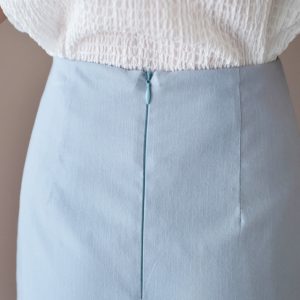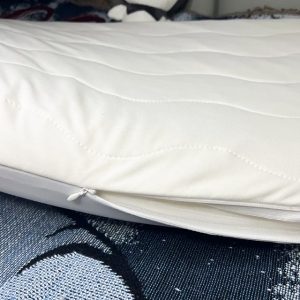
Explorando los conceptos básicos de las cremalleras de la bobina y las cremalleras invisibles
| Característica | Cremallera de bobina | Cremallera invisible |
| Construcción | Hecho con una bobina continua cosida en la cinta de la cremallera | Dientes ocultos detrás de la cinta de la cremallera, solo control deslizante visible |
| Visibilidad | Visible en la superficie de la prenda | Prácticamente indetectable cuando se cierra |
| Usos comunes | Bolsas, chaquetas, zapatos, carpas, mochilas | Vestidos, cojines, fundas de almohadas |
| Flexibilidad | Alta flexibilidad y operación suave | Integración perfecta con telas |
Composición de material y durabilidad
Materiales utilizados en cremalleras de bobina
Cremallera de bobina suelen ser de nylon o un material de poliéster de nylon. En una construcción de bobina, este es el segmento de la cinta de cremallera que se cose alrededor de un solo filamento continuo. Esto hace que las cremalleras de la bobina sean ligeras pero resistentes. Navegan sobre giros sin atrapar ni engancharse. Flotan por encima de las curvas sin atrapar ni enganchar.
Fuerza y flexibilidad de las cremalleras de la bobina
La durabilidad de una cremallera de la bobina proviene del uso de nylon o poliéster, lo que hace que sea más resistente al daño. Estos materiales ofrecen resistencia a la tracción superior al tiempo que son flexibles. Las cremalleras de la bobina se doblan muy fácilmente sin perder la función, lo que les ayuda a ajustar las aplicaciones cuando las cosas deben moverse dentro y fuera de ellos regularmente. Debido a que el diseño de la bobina se dobla fácilmente y no obstaculiza el funcionamiento de la cremallera, estas cremalleras se pueden usar en cualquier aplicación que sugiera movimiento.
Materiales utilizados en cremalleras invisibles
Las cremalleras invisibles también usan nylon o poliéster para su construcción. Sin embargo, presentan un diseño oculto donde los dientes están ocultos detrás de la cinta de la cremallera. Esta construcción única proporciona un acabado suave que combina a la perfección con las telas.
Fuerza y flexibilidad de las cremalleras invisibles
Cremalleras invisibles ofrezca suficiente fuerza para la mayoría de las aplicaciones de prendas a pesar de su delicada apariencia. El diseño de los dientes ocultos contribuye a su flexibilidad, lo que les permite integrarse suavemente en costuras sin crear volumen.
Variaciones funcionales en aplicaciones
Aplicaciones prácticas para cremalleras de bobina
Las cremalleras de la bobina son versátiles y adecuadas para diversas aplicaciones, como ropa de trabajo, chaquetas, zapatos, tiendas de campaña, sacos de dormir, mochilas y usos decorativos. Su durabilidad los hace ideales para artículos que requieren apertura y cierre frecuentes.
Idoneidad para varias telas y productos
Las cremalleras de la bobina funcionan bien con materiales de servicio pesado como lienzo y telas livianas como el nylon. Su adaptabilidad los hace populares en industrias que van desde la moda hasta la fabricación de equipos al aire libre.
Aplicaciones prácticas para cremalleras invisibles
Las cremalleras invisibles se usan comúnmente en vestidos, cojines, fundas de almohadas, carteras y otros artículos donde un cierre discreto es esencial. Proporcionan un acabado ordenado mezclando perfectamente con telas de tapicería.
Idoneidad para varias telas y productos
Las cremalleras invisibles funcionan mejor en telas livianas a de peso medio donde es importante una superficie lisa. Son sin pretensiones, lo que los hace ideales para el uso formal y los textiles para el hogar donde se ve a Trump una actuación difícil. La calidad discreta es lo que los hace ideales para el uso formal y los textiles para el hogar donde la apariencia reemplaza la funcionalidad hardcore.
Técnicas de instalación para cada tipo
Instalación de una cremallera de bobina
Herramientas requeridas y proceso paso a paso
Las herramientas que necesita para instalar una cremallera de bobina: una máquina de coser con un pie de la cremallera, tijeras de tela, alfileres o clips, y posiblemente un desgarrador de costura. Comience marcando dónde irá la cremallera a la tela. Pin o recorte la cremallera en su lugar, alineando la cremallera con la línea marcada. Coser cerca del borde de la bobina con el pie de la cremallera, manteniendo los dientes fuera. Esto estabiliza la cremallera, así que asegúrese de robar ambos extremos. Por último, use un desgarrador de costuras para desbloquear cualquier tela restante que oculte los dientes de la cremallera.
Instalación de una cremallera invisible
Herramientas requeridas y proceso paso a paso
Si está instalando una cremallera invisible, necesitará un pie de cremallera invisible para su máquina, tijeras de tela, alfileres o clips, una herramienta de marcado y una cremallera invisible. Primero, al marcar su tela donde desea que vaya la cremallera. Con los lados derecho juntos, coloque un lado de la cremallera invisible sobre su margen de costura y abra la cremallera hasta el final. Se puede asegurar a un mantel individual con alfileres o clips. Coser justo al lado de los dientes (pero no atraparlos) usando el pie de cremallera invisible en su máquina. Haz lo mismo en el otro lado de tu tela. Después de que haya terminado, simplemente cierre el resto de la costura debajo de la cremallera para que desaparezca cuando cose ambos lados en su lugar.
Consejos de mantenimiento y cuidado
Mantener cremalleras de la bobina
Técnicas de limpieza y reparación
En las condiciones correctas, las cremalleras de la bobina deberán limpiarse regularmente para que sigan funcionando. Retire suavemente la mugre y los escombros de los dientes con un cepillo o tela suave. Para los residuos de aceite resistente, use jabón suave y jabón, pero realmente seque las superficies después de usarse para evitar que las piezas de metal se oxiden si están presentes. Para las cremalleras de la bobina desalineadas o atascadas, un pequeño lubricante como la cera de parafina manchada su longitud lo ayudará a crecer libremente.
Mantener cremalleras invisibles
Técnicas de limpieza y reparación
Debes tener cuidado con las cremalleras invisibles porque son delicadas. Use un cepillo suave para limpiarlos del polvo sin rascar su estructura oculta. No use productos químicos fuertes que puedan disminuir la resistencia de las fibras de nylon con el tiempo. Cuando una cremallera invisible se atasca o se niega a funcionar sin problemas, frotar jabón transparente o lubricantes de cremallera especialmente fabricados a lo largo del camino de la cinta con cremallera funciona mejor.
Tomar la decisión correcta para sus necesidades
Factores a considerar al elegir un tipo postal
Requisitos del proyecto y preferencias personales
Considere las necesidades de su proyecto además de preferencia, al elegir entre una cremallera de bobina y una cremallera invisible. Elija la cremallera adecuada para su tela elegida, las cremalleras de la bobina son más adecuadas para telas pesadas debido a su estructura, mientras que la cremallera invisible está diseñada con telas livianas en mente donde la apariencia es de alta prioridad. No se olvide de los materiales, ya que la cremallera de la bobina es excelente para telas más gruesas debido a su tela fuerte, pero la cremallera invisible es increíble para materiales más ligeros y finos que deben verse sin problemas.
Considere con qué frecuencia se utilizarán: use cremalleras de bobina en bolsas que se abrirán y cerrarán mucho, como las mochilas; Frecuencia de uso: use cremalleras de bobina para cosas que se abren y se cierran con frecuencia (como mochilas);






